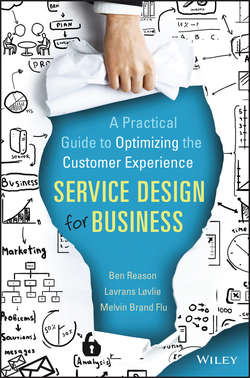Читать книгу Service Design for Business - Løvlie Lavrans - Страница 5
На сайте Литреса книга снята с продажи.
Chapter 1
Why Service Design
Three Trends That Make Service Design Relevant Today
ОглавлениеIt is not a coincidence that service design has emerged in the twenty-first century. Just as industrial and product design emerged with the development of mass manufacturing, service design is responding to some significant economic, social, and technical trends. Three trends, one in each of these categories, set the context for why service design is a growing discipline and of growing interest to more and more businesses and organizations.
Economic: The Trend Toward Value in Services
As economies mature, they move from agriculture to raw materials to manufacturing to services. This trend is a macro one and has already taken place in much of the world. Services comprise 70 to 80 percent of the economies of mature countries and are growing rapidly even in big producer countries such as Brazil. This trend should be thought of as less a replacement of the previous situation but a layering where services add value to manufacturers. Many industries are seeing services as higher-margin businesses than manufacturers.
As differentiation in products reduces with the maturity of industries, services prove to be the area where there is higher potential. Services have the additional benefit of supporting customers to get the best from products and drive loyalty. Service design was invented to respond to this trend, to bring the best design methodologies to bear on a new challenge. The achievement of design in manufacturers is well documented – in industries from automotive to electronics. Design needed to develop to offer these qualities to a new market.
Social: The Increase in Customer Expectations
Consumers are expecting more as they value their own entitlements more than previous generations. Where once people accepted what they got, market economies have trained individuals to expect more. This is accentuated when leading brands create excellent experiences that lead consumers to think, “Why can't all my experiences be like that?” Service providers that were one-size-fits-all, and you get what you are given, have to rethink their approach as customer expectations grow. Government services need to keep up, too, as politics drives them to improve customer experience through national surveys and directives.
This trend in consumer expectations bleeds into the business-to-business arena. Workers used to put up with experiences that were suboptimal and take the brunt of the pain with the logic that they could learn their way around and it was a part of the job. Now the example set by the best consumer services leads people to expect the same at work.
As expectations rise, the need to understand customer needs and expectations develops in parallel. Service design is one strong way to bring the new customer power into the design and improvement of services in a structured and productive manner.
Technical: Growth of Digital Means Change in Services
We are all aware of the impact of the digital revolution. It may be a cliché, but digital technologies have driven radical change and disruption in the service sector. Services that were previously delivered by humans who had a level of expertise can now be partially delivered by technology. Think of financial advice or banking that used to be face-to-face but is more and more online and self-serve. Digital has impacted almost every service sector. Digital disrupts in other ways, too. It can change the established dynamics of a sector and enable new entrants to markets. Amazon in retail is the most obvious example.
Thepotential for change in service, and the fact that what were primarily human-delivered services are now mediated by technology, has driven the need for service design. Technology can dehumanize and make things harder to navigate for customers and less flexible. Service design offers tools to domesticate and humanize technology.
